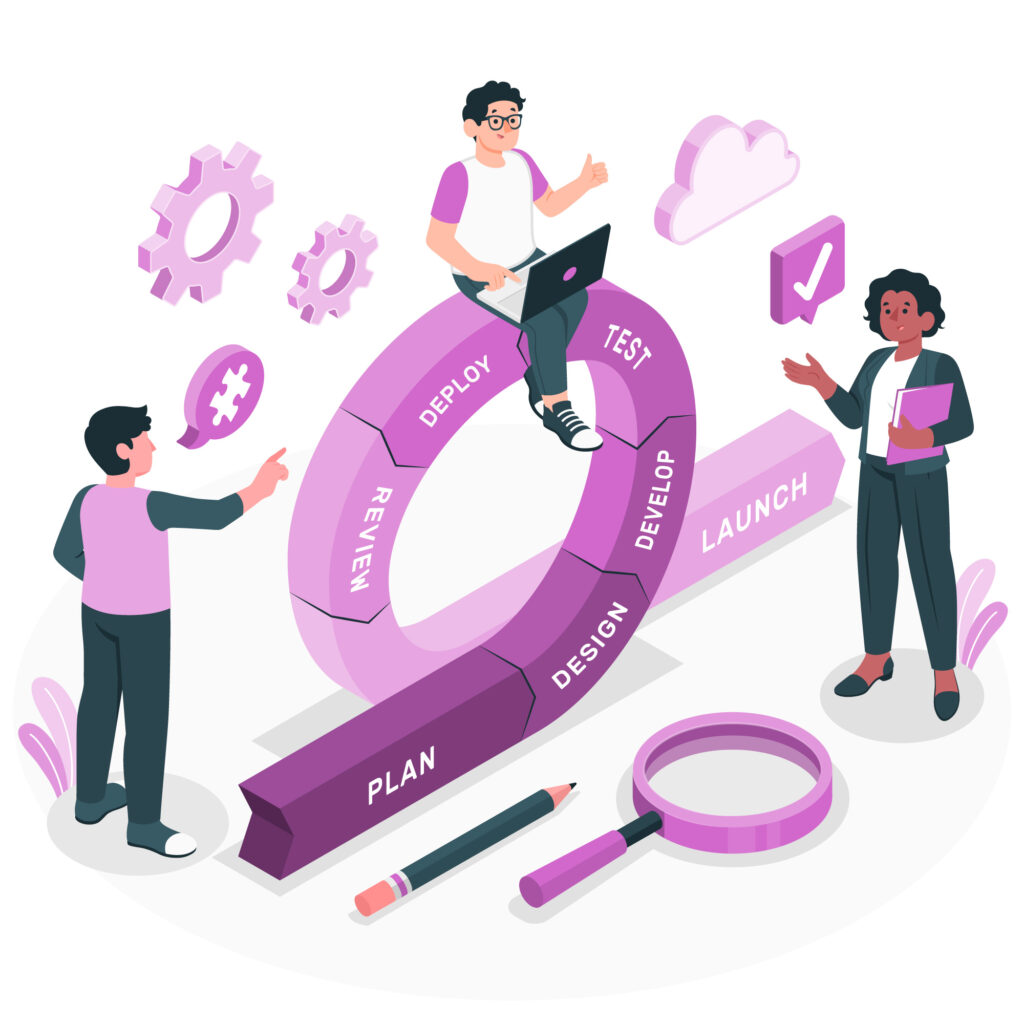SOP Consulting for Retail
In what way are standard operating procedures defined?
Strong performance in a methodical and sensible manner
By defining what is, what is not is also excluded. On the basis of that assumption, it is not necessary to practice anything that does not fall under the definitions. Put another way, there is no need to concentrate on anything else after what is necessary has been determined. SOPs are an effective instrument for strong operational execution because of the same premise. A Venn diagram illustrating this idea is provided below.

Standard Operating Procedures (SOPs) are comprehensive instructional guides that specify the exact steps that must be taken to complete an activity from beginning to conclusion. Using common business examples, the characteristics of SOPs have been described below, based on the previously established idea.
What needs to be done:
A business may choose to post material on their social media handles daily on specific platforms in order to improve their digital outreach. Furthermore, uploading content on any other platform or at any other frequency than once a day is prohibited. The concerned employees’ operational attention shifts back to the few platforms that were chosen, and publishing must be done daily.
Who is responsible:
Businesses often place strict controls on large payments by requiring that only the finance manager or a designated superior can authorize them. This eliminates the chance of unauthorized approvals by other finance team members. As a result, the finance team clearly knows in advance who is permitted to authorize which payments, removing any ambiguity and ensuring adherence to the defined SOPs.
How it should be done:
Customers approach companies with a variety of issues. For instance, telecom companies handle numerous daily complaints about network issues, billing errors, slow internet, and more—each arising from different causes and requiring specific resolution methods. The CRM team must be equipped with predefined procedures to address each complaint type appropriately. For example, a network issue cannot be resolved using the same approach as a complaint about staff behavior.
When it should be done:
The inventory team is expected to raise a purchase requisition when stock levels hit the predetermined reorder point. This point is strategically set considering factors such as lead time for procurement, transit, and quality inspection. Reordering too early might create storage challenges, while delays could result in stockouts and missed customer demand. Hence, timing is crucial and must align with operational needs.
Why it is necessary (intended result):
Employees need to understand the value of their output. A recruiter, for example, should recognize why certain skills are listed in a job description—they are essential for the role being filled. Therefore, shortlisted candidates must meet these criteria. SOPs help reinforce the importance of quality outputs and ensure tasks are aligned with broader business objectives.
Where it should be done:
SOPs often need to specify where an action must occur. In the eCommerce industry, for example, delivery personnel are expected to deliver orders strictly to the address provided by the customer. While informal arrangements may sometimes be made for convenience, delivery staff must stick to the official protocol and not exceed the defined boundaries.
Embracing Automation and Digitization:
Modern businesses increasingly rely on IT-driven automation and digital tools to streamline operations. From digital payments to data-driven decision-making, these technologies are now common across businesses of all sizes.
SOPs provide a vital structure for successfully introducing automation and digitization. Take a retail store as an example—it might not be ready for full-scale automation initially. But with proper systems and workflows in place, the store can gradually transition to digital operations. Suppose it uses a manual inventory register capturing details like product type, supplier, quantity, and dates. These data fields will later guide the selection or customization of inventory management software, ensuring a smoother shift to digital systems.

Faster Operational Maturity to Support Growth
Achieving operational maturity is essential for scaling a business. Without strong control and clearly defined processes in the current setup, expanding operations becomes difficult to replicate effectively. For instance, if a departmental store plans to open two more outlets in the same city but lacks standard procedures in its existing store, the new branches will have no clear benchmarks to follow. This could result in inconsistent management, inefficiencies, or even better performance at new branches than the original—leading to disjointed operations and uneven customer experiences.
Implementing SOPs helps standardize and streamline business operations. This gives businesses a solid foundation when planning for growth or expansion. SOP-driven systems make it much easier to replicate successful processes across new locations. The advantage lies in having a well-established system from the beginning. Waiting to implement SOPs until after expansion risks missing out on the opportunity to achieve operational maturity early and efficiently.
How to create a standard operating procedure that works

Start with Drafting
Among all SOP development steps, drafting comes first—and for good reason. While it may seem old-fashioned, putting procedures in writing has lasting value. Writing brings clarity and ensures goals and tasks are thoroughly defined. Even if software tools are used to manage operations, having written documentation is essential. Skipping this step undermines the foundation of SOPs. Whether in text or visual form, written SOPs help convey the bigger picture and highlight even the smallest gaps or inconsistencies. Early drafting also allows businesses to clearly shape their processes and integrate best practices and industry benchmarks right from the beginning. Expressing plans through writing or diagrams enhances innovation and brings the vision into focus.
Maintaining Focus
SOPs must be purpose-driven—they should directly support operational goals. That means clearly defining inputs, outputs, and performance expectations. Roles and responsibilities, including who executes and who verifies, should be unambiguous. Every operational detail that can be planned, should be.
For example, if a departmental store requires a daily sales report to be sent to the sales head, the SOP should define everything—from the report format and responsible person (with backup provisions) to the timeline and mode of communication. If an SOP fails to produce the expected outcome, it defeats its very purpose.
Encouraging Collaboration
Effective business processes often involve multiple stakeholders—internal and external. These may include employees, vendors, consultants, government bodies, logistics providers, and more. Take payroll processing as an example: statutory deductions must be calculated, deposited, and recorded accurately and on time, often involving several parties. Even within the same department, roles may need to work together to complete a task. SOPs must reflect this interconnectedness by clearly assigning responsibilities to all stakeholders. If these links aren’t addressed, the workflow can break down, leading to missed objectives.
Integrating Digitisation
Today’s SOPs differ significantly from traditional paper-based ones due to the integration of technology. While written documentation remains important, SOPs must now be designed with digital implementation in mind. Since most businesses use software tools for operations, SOPs must align with the capabilities of those platforms.
Your chosen software should be able to carry out the SOP as written—supporting collaboration, ensuring compliance, and maintaining efficiency. A user-friendly interface is key, as employees are the primary users of the platform. In many cases, training may be necessary to help staff adapt to the software environment.
Additional considerations include technical support, system maintenance, and future upgrades, all of which should be factored into SOP planning.
Driving Action
Whether paper-based or digital, SOPs must lead to clear, actionable outcomes. They should leave no room for confusion. For instance, if payroll needs to be processed monthly, the SOP should specify an exact date—not vague terms like “around the middle of the month.” Clear instructions prompt decisive actions, keeping operations on track.
Prioritising Education and Training
Just launching SOPs doesn’t guarantee immediate employee proficiency. Shifting from informal routines to structured procedures can take time, especially for experienced staff used to working independently or for employees joining from organisations with different systems.
Training is vital—especially when SOPs are executed through software. Interfaces may feel unfamiliar at first, and unfamiliarity often leads to errors and inefficiencies. Training ensures employees are confident using the system, resulting in smoother adoption and better performance.
Improving Through Feedback
SOPs aren’t just about consistency—they’re also tools for continuous improvement. Feedback from everyone involved—employees, supervisors, external partners, consultants—helps identify inefficiencies and opportunities for refinement. While not all external parties will actively contribute, it’s essential to encourage internal feedback through regular reviews, audits, or meetings.
However, feedback alone isn’t enough. Leadership must act on it, finalize necessary adjustments, assign responsibilities, and set deadlines for implementation. Continuous refinement ensures SOPs evolve in line with changing business needs.
Challenges in SOP creation and implementation

Insufficient Domain Knowledge and Experience
Although SOPs define how tasks should be performed, there’s no universal method for creating them. While simpler procedures might not pose challenges, documenting complex business operations demands significant domain knowledge and experience.
Take payroll management as an example. In small companies, the process is usually simple due to straightforward salary structures. However, in large organizations, where employee compensation includes numerous variables, payroll becomes highly complex. Companies may outsource it altogether. When handled internally, detailed and well-structured SOPs become essential. These often span multiple departments, roles, and even external entities. Every task, dependency, and timeline must be thoroughly outlined. As the intricacy increases, the value of experience in crafting such SOPs becomes irreplaceable.
Overreliance on Individuals Over Systems
Some online retailers require OTP verification during delivery, which ensures a systematic validation process. Others depend on delivery personnel calling the customer, which shifts responsibility to the individual. Though both aim for verification, only the first is truly process-driven.
When roles and expectations are left vague, employees rely on personal judgment, leading to inconsistencies. These ad hoc practices often become normalized, creating resistance to change. The real challenge isn’t always creating SOPs but enforcing them—especially when informal workarounds have taken root.
Poor Interdepartmental Integration
SOPs must clearly outline how tasks and responsibilities are shared across departments and roles. However, in practice, this level of coordination often falls short. A small oversight—like a store associate forgetting to give a customer their bill—can have legal implications, even if the customer doesn’t request it. SOPs should ensure such responsibilities are consistently fulfilled.
In complex organizations, processes routinely pass through multiple layers of staff and departments. For example, internal audits often require back-and-forth collaboration across teams. Without clearly defined coordination plans, these processes become chaotic. When external players like vendors or regulatory bodies are involved, the challenge grows—especially since companies have limited control over third-party compliance.
Lack of Flexibility in Operational Procedures
SOPs must be robust but not rigid. Anticipating exceptions and alternate scenarios helps operations run smoothly under varied circumstances. For example, leave approval protocols should mention an alternate approver if the designated authority is unavailable. Without such provisions, delays or improvised decisions become inevitable.
Consider a company that updates its payment policy but fails to notify suppliers. This lack of communication can disrupt operations and hurt business relationships. SOPs should include fallback mechanisms and communication guidelines to ensure continuity and minimize impact during unforeseen situations.
Disconnect Between SOPs and Digital Tools
Modern businesses heavily rely on software and automation. However, if SOPs are written without aligning with the intended digital tools, gaps arise. A workflow that works on paper may fail when digitized due to misalignment in logic or features.
Such issues often stem from a lack of technical insight during the SOP drafting phase. For automation to succeed, operational blueprints must reflect how technology will be used. When that connection is weak, companies risk inefficiency despite using sophisticated tools.
Inadequate Training on SOP Implementation
Familiarity breeds proficiency. Employees don’t need to be perfect right away—but they must grow comfortable with new procedures. Over time, repeated exposure leads to mastery.
SOP training—whether hands-on or classroom-based—helps employees internalize procedures and identify areas where they may struggle. The aim is to make complex tasks feel natural. When teams are thoroughly trained, they’re better equipped to follow processes accurately and efficiently.
How we do it: Methodology for SOP Development

It is simple to list the advantages of standard operating procedures, but there is no clear solution for how to develop one. However, by taking a sensible approach to SOP creation and development, this issue can be fixed. When designing and delivering our SOP services and solutions, TRS adheres to predetermined and tested processes. A brief overview of our SOP development technique (How to establish standard operating procedures) is provided below:
Clarifying Process Objectives
A business may aim to streamline its payroll process through SOPs. The first step involves clearly defining the process goals and priorities. These may include methods for salary and incentive calculations, disbursal schedules, the role of HR executives, approval hierarchies, payment modes, legal deductions, regulatory compliance, and cross-departmental coordination. Since these factors vary between businesses, establishing them upfront ensures SOPs are tailored to reflect actual operational priorities.
Capturing Current Workflow Practices
The next step involves documenting how the organization is currently executing the targeted process. This includes observing actual work practices and gathering insights through interaction with key stakeholders. Though it can be time-consuming, this stage yields essential data that forms the foundation for accurate SOP design.
Identifying Operational Gaps
With a clear picture of both the ideal process and current practices, the focus shifts to identifying discrepancies. For instance, company policy may state that salary statements must be approved by HR before being sent to finance, but in practice, this step may be skipped. Such inconsistencies might not cause immediate issues but leave the organization exposed to future inefficiencies or risks. This stage helps bridge those gaps precisely.
Drafting the SOP Framework
Armed with data and insights from earlier steps, our team begins drafting or revising the SOPs. We take into account how changes in one part of the organization may impact other departments or roles. This interconnected approach ensures that the resulting SOPs foster seamless coordination and meet updated requirements effectively.
Pilot Testing and Refinement
Even meticulously designed SOPs can fall short in real-world scenarios. That’s why we validate them through pilot runs in controlled environments. These trials help uncover redundancies, highlight areas needing simplification, and identify opportunities to enhance process reliability—even if it means adding minor complexities. Feedback from department heads and senior management is key to refining the SOPs before final approval.
Recommending Digital Enablement Tools
In today’s digital landscape, businesses often prefer automating their processes. While we don’t sell or develop software, we guide clients in identifying the most suitable digital solutions for SOP implementation. Our assistance includes evaluating software vendors, aligning features with business needs, and setting realistic budgets. The final choice of tools and vendors always rests with the client.
Facilitating SOP Adoption Through Training
We recognize that transitioning to SOP-based operations can be unfamiliar or even overwhelming for employees. Resistance to change is common, especially when automation tools are introduced. Our training programs focus on humanizing the learning experience. The aim is to make employees confident and comfortable with the new procedures before diving deep into operational details.
Establishing a Review and Update Mechanism
Processes evolve over time due to both internal changes and external factors like regulatory updates. A dynamic SOP framework must accommodate such changes through regular assessments and timely updates. For example, if a company modifies its leave policy, related SOPs must be revised accordingly. We ensure this adaptability is built into the SOP ecosystem.
Our goal in offering SOP consulting
Simplifying the Digital Transition
Digital transformation has permeated every industry and aspect of modern business. No enterprise can afford to stay disconnected from it for long. It has fundamentally redefined how businesses operate and deliver value to customers. However, transitioning to digital systems challenges the existing norms and exposes businesses to operational uncertainties. When mismanaged, such transformations can result in serious setbacks.
At TRS, our mission is to make this transformation smooth and manageable for our clients. Our SOP services are engineered with a digital-first mindset, ensuring that they align seamlessly with automation platforms. With our robust and tested SOP development methodology, we follow a “first-shot-hit” approach—minimizing rework and maximizing effectiveness. From planning to implementation, we take all necessary precautions, assist in identifying the most suitable digital solutions, and provide comprehensive training to ensure that employees can confidently adopt and use the new systems.
Boosting Workforce Efficiency
One of the core objectives of implementing SOPs is to enhance the efficiency and effectiveness of business operations. Since employees are the ones executing these processes—often using technology—their productivity directly influences overall performance. Without strong productivity levels, even the best-designed processes will underdeliver.
Enhancing employee performance is a key focus in our SOP services. We strive for this through simplified procedures, clear and intuitive workflows, focused training, supportive change management, and technological enablement. Simplifying steps helps employees quickly grasp their responsibilities and standards. Intuitive documentation makes instructions easier to follow. And our training modules ensure team members are prepared and comfortable before implementation begins.
Delivering Superior Customer Interactions
Exceptional customer experience (CX) is a powerful differentiator in today’s competitive marketplace. It builds loyalty, drives repeat business, and turns customers into brand advocates. Since customer experience is shaped at various touchpoints—ads, websites, social media, delivery, and more—every interaction contributes to the overall perception.
At TRS, we understand the deep connection between SOPs and CX. We ensure that the processes we define support positive, consistent, and reliable customer interactions.
Ensuring Seamless External Interactions
What happens outside your organization is just as important as what happens within. Every business interacts with various external entities—vendors, agencies, regulators, job applicants, etc. Mismanaged interactions in these areas can result in missed opportunities, reputational damage, or even legal complications.
Our SOP consulting approach at TRS goes beyond internal alignment. We also factor in external coordination. Whether it involves setting expectations for vendors or adjusting procedures to meet regulatory demands, our solutions are designed to help your organization operate smoothly across all external touchpoints.
Protecting and Elevating Brand Reputation
Brand image is more than just customer perception—it’s the collective impression held by all stakeholders, including vendors, regulators, partners, and job candidates. A company known for professionalism and reliability across its ecosystem strengthens its brand reputation.
At TRS, we take a comprehensive view of brand management through SOP design. We don’t just focus on efficiency—we also factor in the broader impact of operational processes on brand perception. Our goal is to help you protect and enhance your brand through consistent, reliable, and reputation-conscious SOP frameworks.

